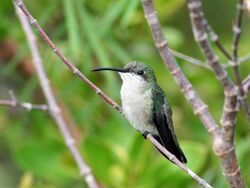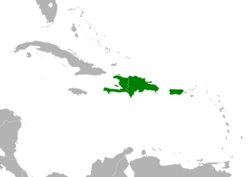Biology:Antillean mango
| Antillean mango | |
|---|---|

| |
| Scientific classification | |
| Domain: | Eukaryota |
| Kingdom: | Animalia |
| Phylum: | Chordata |
| Class: | Aves |
| Clade: | Strisores |
| Order: | Apodiformes |
| Family: | Trochilidae |
| Genus: | Anthracothorax |
| Species: | A. dominicus
|
| Binomial name | |
| Anthracothorax dominicus (Linnaeus, 1766)
| |

| |
| Distribution | |
| Synonyms | |
|
Trochilus dominicus Linnaeus, 1766 | |
The Antillean mango (Anthracothorax dominicus) is a species of hummingbird in the subfamily Polytminae. It is found on the Caribbean islands of Hispaniola (both the Dominican Republic and Haiti), Puerto Rico, the British Virgin Islands, and the American Virgin Islands.[3][4]
Taxonomy and systematics
The Antillean mango was formally described by the Swedish naturalist Carl Linnaeus in 1766 in the twelfth edition of his Systema Naturae under the binomial name Trochilus dominicus.[5] Linnaeus based his description on the "colibry de S. Domingue" that was described and illustrated by the French zoologist Mathurin Jacques Brisson in 1760.[6] The type locality is in the Dominican Republic on the island of Hispaniola (and not the island of Dominica).[7] The Antillean mango is now placed in the genus Anthracothorax that was introduced by the German zoologist Friedrich Boie in 1831.[8][9]
The International Ornithological Committee (IOC), the Clements taxonomy, and the American Ornithological Society (AOS) recognize two subspecies, A. d. dominicus (Linnaeus, 1766) and A. d. aurulentus (Audebert & Vieillot, 1801). BirdLife International's Handbook of the Birds of the World (HBW) treats those taxa as separate species, the "Hispaniolan" and "Puerto Rican" mangoes respectively.[3][10][11][4]
Description
Antillean mangoes of the nominate subspecies A. d. dominicus are 11.5 to 13.5 cm (4.5 to 5.3 in) long; males weigh 6.0 to 8.2 g (0.21 to 0.29 oz) and females 4.0 to 7.0 g (0.14 to 0.25 oz). Adult males have shiny bronze-green upperparts. The chin and throat are metallic green and the rest of the underparts velvety black with a bluish tinge. The tail is mostly violet; the inner webs of the feathers are coppery and the tips blue-black. The female's upperparts are also shiny bronze-green. Its underparts are grayish lightening to pale white on the abdomen. The tail is reddish violet with broad black marks near the end; the outermost feathers have white tips. The juvenile is thought to be like the female but with a black line down the center of the underparts.[12]
Antillean mangoes of subspecies A. d. aurulentus are 11 to 12 cm (4.3 to 4.7 in) long; males weigh 4.8 to 7.2 g (0.17 to 0.25 oz) and females 4.0 to 6.4 g (0.14 to 0.23 oz). The male's upperparts are like those of the nominate. It has green flanks, a dark brownish gray belly, and a bronzy green tail. The female is similar to the nominate but has a brownish gray tail with the same black marks and white tips as the nominate.[12]
Distribution and habitat
The nominate subspecies of Antillean mango is found throughout Hispaniola and several of its small offshore islands. A. d. aurulentus is found on Puerto Rico, its offshore island Culebra, and the British and American Virgin Islands. It is apparently extirpated from the Puerto Rican island of Vieques. On Hispaniola it inhabits a variety of both moist and dry landscapes including clearings, gardens, shade coffee plantations, secondary forest, and coastal shrublands. It occurs generally below 1,500 m (4,900 ft) but is found (though rarely) as high as 2,600 m (8,500 ft). In Puerto Rico and the Virgin Islands it is found almost entirely in lowlands below 250 m (820 ft), where it occurs in gardens and forest edges.[12]
Behavior
Movements
The Antillean mango is resident throughout its range.[12]
Feeding
The Antillean mango feeds on both nectar and arthropods, though details are not well known. It takes nectar from a wide variety of flowering plants and males defend nectar-rich territories. Insects are mostly taken on the wing and spiders from leaves and bark. It forages as high as 20 m (66 ft) above the ground.[12] The species is the primary pollinator for the flowers Heliconia bihai and H. caribaea.[13][14]
Breeding
The Antillean mango's breeding phenology has not been studied; most information is anecdotal. It is believed to breed at any time of the year and perhaps twice a year on Puerto Rico. The nest is a cup of soft plant fibers bound with spider silk and covered on the outside with lichens and bark flakes. It is usually placed in a tree or shrub but on Puerto Rico has been found on human-made substrates such as power lines, antennas, and fences. The clutch size is two eggs. On Puerto Rico the incubation time has been reported to be about 15 days with fledging 22 to 25 days after hatch.[12]
Vocalization
The Antillean mango is thought to be mostly silent, and its song has not been described. The calls of both subspecies include "a repeated short tsip" and "a high-pitched liquid trill".[12]
Status
The IUCN follows HBW taxonomy, and so has assessed the two subspecies separately. It rates both as being of Least Concern. The population size and trend of the "Hispaniolan" mango are not known. The population of the "Puerto Rican" mango is not known and is believed to be decreasing.[1] Both are generally common in coastal areas and "Hispaniolan" is abundant in dry areas. It has been extirpated from some small offshore islands.[12]
References
- ↑ 1.0 1.1 BirdLife International (2016). "Antillean Mango Anthracothorax dominicus". IUCN Red List of Threatened Species 2016: e.T22725737A94901288. doi:10.2305/IUCN.UK.2016-3.RLTS.T22725737A94901288.en. https://www.iucnredlist.org/species/22725737/94901288. Retrieved 11 November 2021.
- ↑ "Appendices | CITES". https://cites.org/eng/app/appendices.php.
- ↑ 3.0 3.1 Gill, F.; Donsker, D.; Rasmussen, P. (July 2021). IOC World Bird List (v 12.1). doi:10.14344/IOC.ML.11.2. https://www.worldbirdnames.org/. Retrieved January 15, 2022.
- ↑ 4.0 4.1 HBW and BirdLife International (2020) Handbook of the Birds of the World and BirdLife International digital checklist of the birds of the world Version 5. Available at: http://datazone.birdlife.org/userfiles/file/Species/Taxonomy/HBW-BirdLife_Checklist_v5_Dec20.zip [.xls zipped 1 MB] retrieved May 27, 2021
- ↑ Linnaeus, Carl (1766) (in Latin). Systema naturae : per regna tria natura, secundum classes, ordines, genera, species, cum characteribus, differentiis, synonymis, locis. 1, Part 1 (12th ed.). Holmiae (Stockholm): Laurentii Salvii. p. 191. https://www.biodiversitylibrary.org/page/42946387.
- ↑ Brisson, Mathurin Jacques (1760) (in French, Latin). Ornithologie, ou, Méthode Contenant la Division des Oiseaux en Ordres, Sections, Genres, Especes & leurs Variétés. 3. Paris: Jean-Baptiste Bauche. pp. 672-373, Plate 35 fig 4. https://www.biodiversitylibrary.org/page/35953795.
- ↑ Peters, James Lee, ed (1945). Check-List of Birds of the World. 5. Cambridge, Massachusetts: Harvard University Press. p. 26. https://www.biodiversitylibrary.org/page/14480037.
- ↑ Boie, Friedrich (1831). "Bemerkungen über Species und einige ornithologische Familien und Sippen" (in German). Isis von Oken 24: Cols 538–548 [545]. https://biodiversitylibrary.org/page/27512960.
- ↑ Gill, Frank; Donsker, David; Rasmussen, Pamela, eds (January 2021). "Hummingbirds". IOC World Bird List Version 11.1. International Ornithologists' Union. http://www.worldbirdnames.org/bow/hummingbirds/.
- ↑ Clements, J. F., T. S. Schulenberg, M. J. Iliff, S. M. Billerman, T. A. Fredericks, J. A. Gerbracht, D. Lepage, B. L. Sullivan, and C. L. Wood. 2021. The eBird/Clements checklist of Birds of the World: v2021. Downloaded from https://www.birds.cornell.edu/clementschecklist/download/ Retrieved August 25, 2021
- ↑ "Check-list of North and Middle American Birds". American Ornithological Society. June 29, 2021. http://checklist.aou.org/taxa.
- ↑ 12.0 12.1 12.2 12.3 12.4 12.5 12.6 12.7 Kirwan, G. M., J. del Hoyo, K.L. Schuchmann, N. Collar, and P. F. D. Boesman (2020). Antillean Mango (Anthracothorax dominicus), version 2.0. In Birds of the World (S. M. Billerman, B. K. Keeney, and T. S. Schulenberg, Editors). Cornell Lab of Ornithology, Ithaca, NY, USA. https://doi.org/10.2173/bow.antman1.02 retrieved January 18, 2022
- ↑ (in en) Hispaniolan Mango (Anthracothorax dominicus). doi:10.2173/bow.antman1.02. http://www.hbw.com/species/hispaniolan-mango-anthracothorax-dominicus. Retrieved 2019-05-25.
- ↑ Martén-Rodríguez, Silvana (December 2011). "Plant–pollinator interactions and floral convergence in two species of Heliconia from the Caribbean Islands". Oecologia 167 (4): 1075–1083. doi:10.1007/s00442-011-2043-8. PMID 21792557. Bibcode: 2011Oecol.167.1075M.
Wikidata ☰ Q580094 entry



